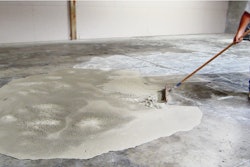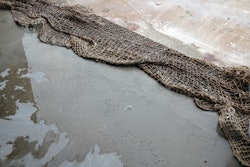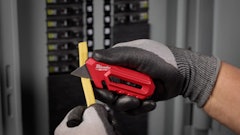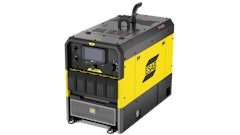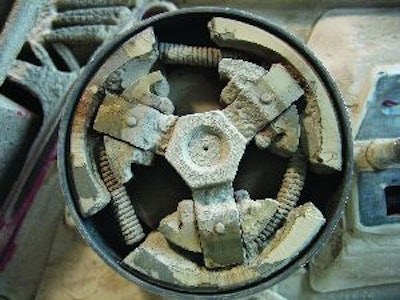
When you start your concrete saw at the beginning of each day, you take for granted it will respond immediately. But given that it spends its entire life surrounded by clouds of dust or pools of slurry, plus works at extreme operating temperatures with less than gentle handling, it's almost surprising that it does.
There are things you can do to combat the conditions concrete saws face and ensure they start promptly and run efficiently. It begins with regular maintenance.
"Simple regular maintenance will help to greatly increase the productive life of concrete saws, while maintaining their future value," says Troy Halverson, senior service representative, Wacker Corp. "With the cost of saws ranging from a few hundred dollars for hand-held [models] to thousands for floor saws, routine preventive maintenance costs pennies on average over the life of the equipment."
Most problems affecting concrete saws are related to three key areas: air filtration, belt/chain tension and starters. Focusing on these areas goes a long way toward extending saw life.
Keep air flowing
Maintenance of a concrete saw's air filtration system can't be overemphasized. Check the operator's manual to determine the proper maintenance intervals and procedures for your particular model.
Currently, there are a few different types of filters available. Traditional foam/oil filters need to be checked and cleaned routinely. Wash in soap and water, then soak them in oil.
Halverson recommends cleaning or changing foam pre-filters whenever you refuel. "Consider having several pre-filters in plastic bags on site and ready to go to reduce downtime," he says.
These machines will also have a paper element. Recommendations for cleaning these filters have changed in recent years. Historically, contractors were taught to clean them with compressed air. "But the combination of high-pressure air and abrasive concrete dust will eventually cause micro tears in the paper," says Joe Hickey, industrial products manager, STIHL, Inc. "Then, the dust will go right through and get into your engine."
It is now recommended that you visually inspect the main paper element for any damage and replace it if any is found. "Otherwise, this filter should not require frequent cleaning or changing," says Halverson. "If it does need service, gently tap it out on a flat surface. Never wash it. And when in doubt, toss it out and replace it."
Manufacturers are introducing new filtration systems in an effort to curtail damage done by concrete dust and slurry. Husqvarna's air cleaning system cleans the air via cyclonic force that removes any large particles. "You remove a lot of the dirt and debris before you take it into the air box," says Mike Ward, product manager, power cutters, Husqvarna. "Then it's filtered again through a three-stage filter."
STIHL offers a relatively new type of air filtration system, X2, that includes a manifold pre-filtration system, a paper element and a cotton flock filter. The company recommends that you don't clean these filters; in fact, don't even open the cover to examine them. "Filters actually clean a little better when they have some filter dust on them," Hickey explains. "At some point, it will get so clogged that no air will get into the engine. The machine won't rev up, or it may bog down and you will notice a drop in power. Then, change the filters."
To further reduce dust exposure to both the operator and machine, there are a number of attachments available that connect directly to the saw to collect dust at the source, notes Becky Gallert, demolition product manager, Wacker.
Manufacturers are also encouraging a move to wet cutting. In fact, some states are beginning to mandate the use of water because of the dangers of silicosis.
Wet cutting still requires attention to air filters. Although most wet cutting saws have sealed air boxes, water can find its way into the intake in some operating positions, says Kent Johnston, education and market development, ICS Blount. A cotton filter will absorb the water and dust and turn it into a paste that sticks to the filter and blocks it off. While water doesn't stick to polyester filters, it will pool at the bottom of the intake. If enough water gets in, it will get sucked around the filter because of the air being drawn into the motor.
To maintain adequate air flow, check the air filter after each cut. Make sure it is dried off or replaced if needed.
Filters and fluids
If you're maintaining a relatively clean environment, you won't have to change the fuel filter very often. Yet, the potential exists for dirt to get into the tank via several avenues. One is the fuel can, which can "attract" dirt after sitting around on a jobsite. Before refueling, clean the area around the fuel cap; if you're using a funnel, make sure it is clean.
You can extend saw life by using fresh fuel that is 89 octane or higher. "Higher octane fuels have more additives that are important for protecting the engine components," says Hickey.
Don't use fuel that is over 10% ethanol. Excess ethanol will make the engine burn a lot hotter, and can wear away some of the fuel lines.
Also be aware of oxygenated fuels typically used in the winter in northern climates and at higher altitudes. While they help with winter gelling and burn cleaner for emissions, they can cause problems with overheating.
Moisture in fuel can be a problem in higher humidity areas, such as Florida. "Moisture in the air or fuel increases the operating temperature inside the motor," says Johnston. "The water will burn through the engine, and the increased temperature can drastically affect saw life. The metal expands and softens and the parts wear out faster. Also, at higher temperatures, depending on its quality, the oil can burn off and lose its lubricating properties."
Using high-quality oil - at the proper ratio - can help alleviate some of these issues. "The best oils are synthetic oils," says Hickey. "They hold up better to the heat. They are a little more expensive, but they should reduce engine wear."
For hand-held saws, use the correct type of oil to properly lubricate the internal parts. Two-cycle oils have evolved greatly in the past few years, so one oil will no longer work for every situation. "Modern, air-cooled, two-cycle engines require oils providing lubrication in extreme operating temperature ranges," says Halverson. "Always use the oil and mix ratio recommended in your owner's manual."
Check belt and starter
Most belts used on concrete saws are made of rubber that will stretch over time. If the saw uses a V-type belt, check the tension at the beginning of each day. If you notice some wheel (blade) slippage during operation, make sure to tighten the belt.
Manufacturers continue to introduce belts/chains intended to be more maintenance-free. Husqvarna saws now feature a flat serpentine-type poly V-belt that resists stretching. "We've seen these belts run for months without having to adjust them," says Ward.
Problems with the starter rank high on the list of reasons contractors return a saw, says Johnston. Check the condition of the rope on a daily basis. Clean and rinse the starter and clutch. If the manufacturer recommends it, spray the starter (but not the clutch) with some type of penetrating oil to help displace the water, so the clutch spring and components don't rust as the saw sits idle between uses. Dry the clutch but don't lubricate it.
The same maintenance should be carried out on concrete chainsaws. Spray the penetrating oil on the bar and chain, even if the saw is used daily. "The water channel that lubricates the nose sprocket and bearings in the nose is smaller than a pencil lead, so it doesn't take much to block it off," says Johnston. "A little surface rust that builds up over a couple of days can create some issues."
Daily inspection
Conduct a general inspection before starting the saw each day.
Because saws vibrate quite a bit, perform a visual inspection to see if any exterior screws need to be tightened before you begin operation. Make sure all the mechanical parts are in proper working order, and correct any malfunctioning controls before using the saw.
Be sure to check the throttle. "If it isn't in proper adjustment, the machine won't run to its full rpm and productivity will go down," Ward explains. "You will be fighting the machine instead of paying attention to the task at hand."
Also check belt/chain tension. While some
belt saws have semi-automatic or automatic self-tensioning units, tension still needs to be checked regularly. Chainsaws will require tensioning more frequently.
Post-use maintenance should include cleaning the saw daily, or at least weekly. "Concrete, rock, stone, etc. is very abrasive and creates a lot of dust/slurry when cut," says Ward. "Those materials can build up in and around moving parts and cause premature wear. The outside of the machine also gets buildup and this cuts down on the cooling of the engine which can prevent it from performing at its maximum or cause damage to the engine. You have extra weight to carry, and who wants to carry extra weight? You affect the whole performance of the machine if you don't clean it regularly."
Although compressed air is preferred for models incorporating electronics, a power washer can be used on some units. "Using a pressure washer on caked-on buildups must be done with care so as not to cause damage," Halverson cautions.
After washing, grease any points where fittings are provided. Inspect and lubricate all manual controls to ensure free movement and proper operation.
You will also want to occasionally (monthly or yearly) inspect the drive system. Depending on the type, it may need little or no service. Hydraulically driven systems may require that fluids and filters be changed, while mechanically driven systems may need service to clutches, belts or chains.
Maintain the blade axle by disassembling, cleaning and inspecting it. Re-grease or replace any bearings that need attention. Check the shafts for any wear or bending, and replace if found. Clean and lubricate the various components of the blade drive system. Also make sure all guards are in place and tight, and the water attachment (if applicable) is secure.
In addition, check the thrust washer that holds the cutting wheel on the machine. "Contractors can over tighten the thrust washer and de-tension it," says Hickey. "You need to have the wheel tight, but don't overdo it."
Although all of these maintenances recommendations can seem daunting, Johnston assures this isn't the case. "While it sounds like there are a lot of tasks to perform, maintenance on a concrete saw really takes less than a few minutes each day," he says. "It's a quick process that can extend the life of your saw."
Operating Tips for a Better Cut
Performing preventive maintenance on your concrete saw can go a long way toward promoting productivity. Combine it with the following operating tips to get the most from these tools.
Properly warm up the saw - Give the saw a 5- to 10-minute warm-up so that components are at the same temperature. Pistons and cylinders tend to shrink and swell as they start to get warm, says Kent Johnston, ICS Blount, and won't fit properly until fully warmed up.
Use the right wheel/chain - Know the type of material you're cutting so you can determine the proper wheel or chain. Cutting cured concrete will require a different type of wheel or chain than cutting green concrete.
Maintain a constant engine rpm -When you cut at the highest rpm, the saw is cutting at the optimum level for which the blade is designed. "Cutting at half-throttle, or feathering it, you're not using the blade at its optimum design performance," says Mike Ward, Husqvarna.
An experienced operator can hear and feel if the saw is not running optimally and is "bogging" down, adds Becky Gallert, Wacker Corp. Operating habits that can cause the engine to bog down include excessive forward travel speed and an initial cut depth that is too deep. A blade that is glazed over and is no longer properly grinding the material can also wreak havoc with the engine, as can too much side load on the saw.
Don't force the cut - Leaning on the machine puts too much load on the engine. "It can overheat the engine and start to wear down the machine," says Joe Hickey, STIHL, Inc. "Plus, the wheel can get too hot. It can start to crack the core or damage segments."
To avoid bogging down the machine, start by making an initial 1- to 2-in. cut, then step cut to achieve the desired depth. "Go a few inches at a time," says Johnston. "Don't take the blade or bar and try to cut it all at once. That can cause damage and prematurely wear out consumables."
Cut straight - Keep pressure up and down so you don't side load the wheel. "It makes cutting less efficient because you're making a wider cut than is necessary," says Hickey. "And you're putting more load on the engine and you can damage the wheel."
Pay attention to operating position - Flywheels are typically located on the left side of the machine. "Sometimes, contractors will try to keep the flywheel side of the saw down," says Johnston. "But the flywheel is what cools the saw and draws air into the motor. If you're wet cutting, all the dirt, water, etc. tend to go to the bottom of the saw, so it also tends to draw [all of that] into the motor. That causes a lot of damage."
Cut safely - To reduce the risk of kickback injury, avoid cutting with the upper quadrant of the wheel where possible. Also, be sure to wear appropriate safety apparel (steel-tipped boots, gloves, glasses, helmet system with face shield, ear protection). Full-length pants and long-sleeved shirts are also recommended. If you're dry cutting material that contains silica, wear a respirator.




